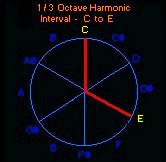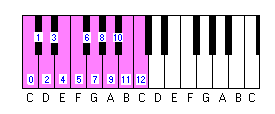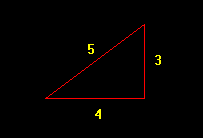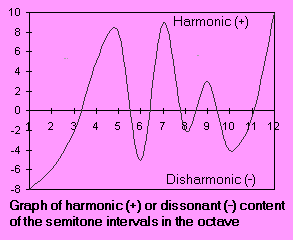 |
Metaphysics of Music and Harmony |
 |
Metaphysics of Music and Harmony |
There is a curious relationship between harmonic and disharmonic content of music and numbers. This same relationship occurs in music, colors, and other physical concepts. It seems as if the Creator creates patterns within patterns and illustrates concepts through numbers. Many patterns that appear in one place are repeated in another. We see this fact throughout life. Time and music both have lower and higher octaves. The octaves of time span a day, a year, and a lifetime. For example the times of the day and the seasons of the year can be compared to the stages of a living entity.
| Morning | Noon | Afternoon | Midnight |
| Spring | Summer | Fall | Winter |
| Youth | Maturity | Middle age | Old Age |
Thus we see the cycle of life is repeated in miniature in the year, and even during a single day. Strangely, astrological predictive techniques use exactly this concept in reverse. The astrological events of the days following birth impact the person in the corresponding year. The astrologer examines the relative positions of the planets of the solar system with respect to the earth for the days following birth. The rule is a year for each day. For example the good and bad aspects (ie angles between planets) occurring X days following birth will show up in the same numbered year of the subject's life. Thus if Mars forms an exact 180 degree angle with Saturn on the 33rd day after birth, the 33rd year of birth will be similarly afflicted with this evil or malefic aspect between the two planets. Here we see in effect the reflection in a higher time octave of an event occurring in the lower time octave. This rule has been followed for centuries by astrologers who have made astonishing predictions based on its use. Unfortunately all the dynamics of astrology are not yet known so the science of astrology is somewhat limited today.
Octaves appear in many places: time, the musical vibrations of sound, and in the electromagnetic spectrum (infrared, visible light, ultraviolet light, and beyond). In music, the doubling of sound frequencies represents an octave. The frequency of the highest note in an octave is exactly two times the frequency of the lowest note in the octave. Within an octave we progress through the seven musical notes C, D, E, F, G, A, B and arrive at C again - one octave higher. There is a striking similarity between the musical octaves and the octaves of the electromagnetic spectrum that we see as visible light. Just as in music with it's seven notes, we commonly say that there are 7 distinct colors in the spectrum of the rainbow.
| Red | Orange | Yellow | Green | Blue | Indigo | Violet |
| C | D | E | F | G | A | B |
An interesting aside is the prominence of the numbers 7 and 12 in music and time. There are seven whole notes in the octave and 12 half steps in the octave. We also see the prominence of these same numbers in our time divisions - 12 hours each of day and night, 7 days in a week, 12 months in the year.
When we divide the octaves of music and color into intervals we find another interesting phenomenon. If we consider the octaves as circles we find that points on the opposite sides of the circles are disharmonic. Thus in viewing the standard color wheel where the colors are arranged around a circle, we see that if we take two opposite colors, we say they clash. For example blue and orange, or purple and yellow.
 | Opposite sides of the color wheel (outer rim) are half an octave apart. These combinations are said to clash or be mutually disharmonic. |
| Orange - Blue, an example of two colors a half octave apart | |
| Purple - Yellow, another disharmonic combination of opposites |
This half-octave dissonance occurs both in colors and in sound. If we take the note C and advance ½ way up the octave (ie 6 half steps upward) we arrive at the note F#. If we play C and F# together we find the combination harsh and disharmonic. Oddly, if we go just one step further and play the note C and G we find the interval to be very pleasant and harmonic. And so we find that the interval 6 (exactly one half the octave) is distinctly disharmonic. In metaphysics the number 6 often represents evil (the devil = 666) while good things often are seven in number (such as the seven Archangels, seven regents, seven sisters of the Pleiades, etc).
Taking opposite sides of the octave or color wheel, is equivalent to dividing the octave by 2. As we have seen, dividing the music or color octave by two produces disharmonic combinations. The number 2 has connotations of dissonance and conflict. The number one by itself is perfect, whole, at peace, and self contained. But the number two implies polarity, opposition, conflict, tension.
In the beginning there was only one, the unmanifest creation, waiting as the cosmic egg for the time of creation. When creation began, the One differentiated into Two - matter and spirit. Really, spirit and matter are different states of the same thing - like ice and liquid water, as physics and relativity have demonstrated. Matter is inertia, weight, potential, and darkness. Matter must be imbued with spirit which is energy, movement, light, and potency. The flow of current between the positive and negative poles of the universe (spirit and matter) is the current that drives forward creation. The polarity of spirit and matter is the basis of manifested creation. Before creation, all the spiritual or Atmic sparks were unified into a single entity. During manifestation, the atmic spirit finds itself coated in sheathes of ever denser matter and loses its sense of identification with the ocean of spirit (Param-Atma) from which it emerged. The embodied Atma is bombarded with the sensual stimuli of manifestation which it takes as reality and thus it forgets its pure spiritual status. It then considers itself to be a single entity apart from all the other Atmic spirits. It becomes an individualized wave on the ocean of existence. The journey of evolution proceeds as the Jiva or embodied Atma experiences the pairs of opposites of manifestation. For example in manifestation the Jiva experiences alternating states of cold or heat, hunger or fullness, gain or loss. These units of individualized life must evolve and experience embodiment for eons through successive forms until eventually realizing once again that their true nature is spirit and that they are really one with the ocean of spirit from which they emerged. As each embodied Atma regains this knowledge in the state of enlightenment, the individual merges back into the unity from which it emerged, no longer identifying itself with any specific individualized form.
 |
Dissonance Turning Harmonic In the Cosmic Harmony CD  |
During manifestation the polarity of spirit and matter is reflected symbolically in many ways.
| Male | Female |
| Positive | Negative |
| Spirit | Matter (Mater) |
| Father | Mother |
| Sperm | Egg |
| Light | Shadow |
In metaphysics Duality (the number 2) is the deeply engrained belief that "I exist apart from the Creator". This is our fundamental human point of view even if we are convinced intellectually that the entire universe and everything in it is nothing but God. In the stage of duality, we experience and suffer the pairs of opposites of the universe (hot cold, gain loss, pleasure pain, etc). Symbolically this aspect of duality is shown to us in the disharmonic half octaves of light and sound. Coincidentally, in astrological phenomenon, any two planets forming a 180 degree angle (half circle) with the earth are also said to be disharmonic or in opposition and the worst attributes of the two planets are accentuated.
The union of spirit with matter in form produces consciousness (the Son aspect). The entire human process of reproduction and birth is laden with reflective symbols of the Cosmic creation. During the process of creation, the male - female polarization occurs, in turn reflecting the properties of spirit and matter respectively as the male and female poles.
Symbolically, Man as a species represents the Son aspect (the fecundation of matter and spirit), because, of all the animal forms, the indwelling God or Atmic consciousness is most fully present in the human animal. Man represents the half way point between the tiny atom of matter and the Cosmic Atom of the universe. It is said:
That is because man in the collective sense literally becomes the "hands and feet" of God on the Earth plane - the middle ground of manifestation between the microcosm of the atom and the macrocosm of galaxies and galactic clusters. When fully Divinized, the individual human becomes an instrument of the Divine on Earth, carrying out the Divine purpose. As a species we are still in an evolutionary stage but we are on the verge of the next great leap forward which is to realize in the collective consciousness our divine heritage and to refocus from personal interests to Divine interests. As the projected aspect of God in matter, Man becomes the middle entity between Spirit and Matter. In this threesome we find the trinity of the Christian religion: Father, Son, Holy Ghost. Matter is the Holy Ghost because it is the shadow (ghost) of spirit and is matter consisting of living atoms and imbued with all the intelligence that emanates from the Creator (hence, for example, the complex crystal forms and atomic bonding forming molecules capable of reproducing themselves). In Vedic thought the trinity is spoken of in terms of the stages of the cyclic appearances of the manifested universe spun out from the One entity called Brahman, Brahmam and other various titles by diverse religions. Brahman is said to be above, below, behind and within all manifestation. In the Vedas, the three stages of the manifested universe are identified as - creation (Brahma), preservation (Vishnu or Mahavishnu), destruction (Shiva or Rudra). These stages may also be denoted as Generation, Organization, Destruction which in their entirety make up the One - G. O. D.
| Spirit | Consciousness | Matter |
| Father | Son | Holy Ghost |
As we have seen the One differentiates into two which in turn produces three. The number three is considered a good and beneficial number. In the color wheel, colors separated by one third of the visible octave (as opposed to 1/2 the octave) no longer clash, Red - Blue for example. In astrology, if two planets form a third of a circle with the earth (ie 120 degree from one another) the aspect is considered to be beneficial. In fact the trine as it is called, is more beneficial than any other aspect. In Geometry, a three sided object forms a rigid, stable shape. In music, notes one third of an octave apart (ie 4 semi tones or half tones apart) are very harmonic: the combination of C with E for example.
 |
Colors one third octave apart (ie 120 degrees around the color wheel), are mutually harmonic - Red / Yellow for example. |
 |
An example of one third octave in the musical scale, the harmonic interval C to E |
 |
An example of one third of a circle in astrology. In this instance, the 120 degree aspect formed between Saturn and Mars is considered to bring out the best in the planetary influences of these traditionally malefic (i.e. un-fortunate) planets. |
In music, the major chords are happy and auspicious sounding and are fully harmonic. The minor chords are considered sad sounding and have dissonant elements in them. C Major is used possibly more than any other chord and often appears as the final chord of a musical passage. The chord of C major consists of the notes C, E, G, and C of the next octave up. If we look at this in terms of half tones we find we start at C, go up one third octave (4 semi tones) further to E and then up one fourth octave (3 semi tones) to G.

We can number intervals of the Octave (shown in pink below) by counting from C (zero) to the next C (12 steps above C).

If we examine the C major chord using these interval numbers we find the following.
| Notes in the Chord | C | E | G | C |
| Half notes from C | 0 | 4 | 7 | 12 |
| Interval between notes | N/A | 4 | 3 | 5 |
Notice how the intervals (i.e. number of half tones between notes) of the major chord in semi tones is 4, 3, 5. Here we have the perfect Pythagorean triangle with a base of 4, a height of 3 and a hypotenuse (diagonal) of 5.

The circumference of the triangle forms the whole octave (4+3+5 = the 12 semi-tones of the octave). Remember from geometry that the sum of the squares of the two sides equals the square of the hypotenuse
4 X 4 + 3 X 3 = 5 X 5.
If we select any note and then move up x number of semi tones and select a second note, and then sound the two notes at the same time they will produce a harmonic or disharmonic effect on one another depending on the number of semi tones separating them. We can graph the harmonic content of the various intervals between two notes by arranging the intervals horizontally and letting the harmony or disharmony that results by sounding these two tones be shown by a point above or below the horizontal line.

Note the most dissonant tones are when two notes are very close together such as C and C# (C# is the black key above C). C and D (separated by two semitones or one sixth of an octave) sounded together are also dissonant but not quite as much. An interval of 3 seems to be neutral to slightly disharmonic. The intervals 4, 5, and 7 are increasingly harmonic but note that when we hit the interval 6 (one half octave), the combinations sounds distinctly disharmonic. Again the number 8 drops below the line as a disharmonic interval.
Playing just two notes together forms a simple interval between the two notes, but when we sound a third tone, then it also forms two new interval combinations between the other two notes. For example in the three main notes of the C Major chord, we sound C, E, G. C to E is 4 steps. E to G is 3 steps. C to G is 7 steps.
| C | E | G | ||
| 4 | 3 | |||
| 7 |
All the chords in the commonly used diatonic musical scale represent various combinations of the 12 intervals in the octave. As we have seen, all the major chords are based on the intervals 0 4 7 12. The minor chords are 0 3 7 12. No matter what key you start with, if you count up the number of intervals between notes, you can determine what notes to play to form any particular chord using the interval pattern for that chord. For ease of playing, some chords are commonly played by dropping one or more notes down one octave - for example the C 6th chord can be played C E G A or G A C E.
Here are the intervals of some of the more common musical chords. The example notes shown are in the key of C (the starting position) but the interval values apply to all other keys as well.
| Major | C | E | G | C | 0 | 4 | 7 | 12 | |
| Minor | C | Eb | G | C | 0 | 3 | 7 | 12 | |
| Seventh | C | E | G | Bb | 0 | 4 | 7 | 10 | |
| Minor Seventh | C | Eb | G | Bb | 0 | 3 | 7 | 10 | |
| Major Sixth | C | E | G | A | 0 | 4 | 7 | 9 | |
| Minor Sixth | C | Eb | G | A | 0 | 3 | 7 | 9 | |
| Diminished | C | Eb | Gb | A | 0 | 3 | 6 | 9 | |
| Augmented | C | E | Ab | C | 0 | 4 | 8 | 12 |
By looking at the intervals in the chords you can see the relative harmonic and disharmonic content. Most music uses a variety of harmonic and dissonant elements. One parallel between life and music is that perfect happiness, like perfect harmony seldom exists for long. Music and life consist of periods of happiness (harmony) intermixed with sadness (dissonance). Manifestation exposes us to the pairs of opposites. Birth and death arise simultaneously. In other words death is the inevitable effect of the cause birth. We wouldn't know light without darkness. We can never know pleasure without also experiencing pain. We wouldn't appreciate happiness half as much as when we experience dis-ease and then have that discomfort or lack of ease suddenly removed. When we hear a sequence of chords we appreciate the dissonant elements as interesting and when they suddenly turn harmonic as on an ending, it creates an inspirational feeling. Some intervals cry out for resolution as for example when we play the 0 11 interval we sense it is just short of the full harmonic octave so we finish by moving to 0 12 and it creates a sense of harmonic completeness. Playing a sequence of chords somehow stirs the soul and evokes feelings buried deep within us. Music adds a further dimension to life just as colors do. We could live quite functionally in a black and white world or a world without music. The presence of both is another of the calling cards of the Creator, enriching the quality of our life experience. In the final sojourn of our earth journey we move to sound the harmonic chords of love, service and compassion and resolve the symphony of our human career into the Ocean of Existence, Knowledge, Bliss from which we individualized so long ago.
 |
 |
|
| <---Back to Cosmic Harmony Home Page |
Forward---> to Cosmic Harmony the CD |